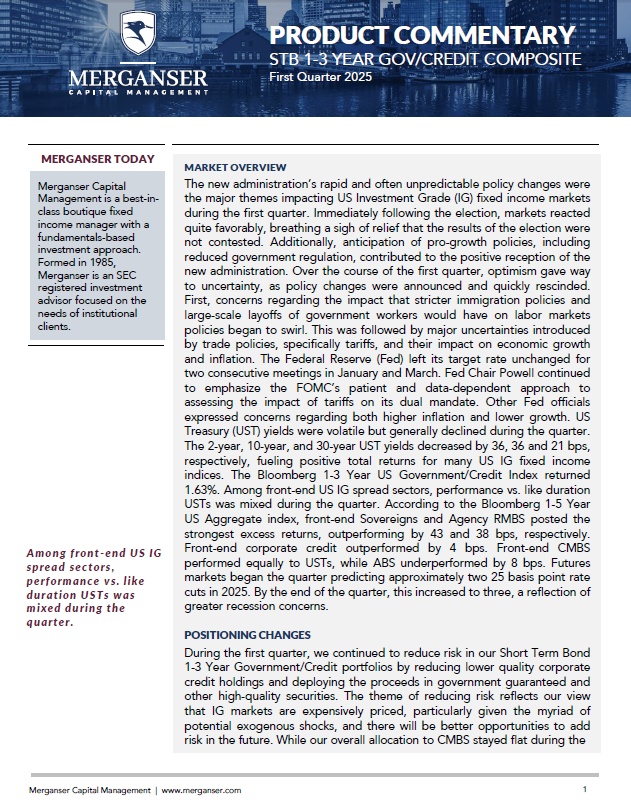MARKET OVERVIEW
The new administration’s rapid and often unpredictable policy changes were the major themes impacting US Investment Grade (IG) fixed income markets during the first quarter. Immediately following the election, markets reacted quite favorably, breathing a sigh of relief that the results of the election were not contested. Additionally, anticipation of pro-growth policies, including reduced government regulation, contributed to the positive reception of the new administration. Over the course of the first quarter, optimism gave way to uncertainty, as policy changes were announced and quickly rescinded. First, concerns regarding the impact that stricter immigration policies and large-scale layoffs of government workers would have on labor markets policies began to swirl. This was followed by major uncertainties introduced by trade policies, specifically tariffs, and their impact on economic growth and inflation. The Federal Reserve (Fed) left its target rate unchanged for two consecutive meetings in January and March. Fed Chair Powell continued to emphasize the FOMC’s patient and data-dependent approach to assessing the impact of tariffs on its dual mandate. Other Fed officials expressed concerns regarding both higher inflation and lower growth. US Treasury (UST) yields were volatile but generally declined during the quarter. The 2-year, 10-year, and 30-year UST yields decreased by 36, 36 and 21 bps, respectively, fueling positive total returns for many US IG fixed income indices. The Bloomberg 1-3 Year US Government/Credit Index returned 1.63%. Among front-end US IG spread sectors, performance vs. like duration USTs was mixed during the quarter. According to the Bloomberg 1-5 Year US Aggregate index, front-end Sovereigns and Agency RMBS posted the strongest excess returns, outperforming by 43 and 38 bps, respectively. Front-end corporate credit outperformed by 4 bps. Front-end CMBS performed equally to USTs, while ABS underperformed by 8 bps. Futures markets began the quarter predicting approximately two 25 basis point rate cuts in 2025. By the end of the quarter, this increased to three, a reflection of greater recession concerns.
POSITIONING CHANGES
During the first quarter, we continued to reduce risk in our Short Term Bond 1-3 Year Government/Credit portfolios by reducing lower quality corporate credit holdings and deploying the proceeds in government guaranteed and other high-quality securities. The theme of reducing risk reflects our view that IG markets are expensively priced, particularly given the myriad of potential exogenous shocks, and there will be better opportunities to add risk in the future. While our overall allocation to CMBS stayed flat during the quarter, our underlying holdings shifted away from private label and SASB, and towards government-guaranteed Agency CMBS. We decreased our allocation to corporate credit, where our focus remained on reducing lower quality holdings for which compensation per unit of risk continued to hover near historic lows. We deployed the proceeds in short SSA (Sovereign Supranational Agency) paper, where we found relatively attractive spreads vs. USTs for extremely high-quality issuers. We modestly decreased our allocation to ABS. ABS spreads tightened meaningfully at the end of the fourth quarter and hovered near those levels until late in the first quarter. Similarly, we decreased our allocation to Agency RMBS, where voracious investor demand drove spreads tighter. In terms of portfolio duration, we maintained neutral positioning relative to the benchmark (+/- 5%).
OUTLOOK
A global economic realignment is underway and ‘tariff on/off’ feels like the new ‘risk on/off’ moniker for markets. The whipsaw is taking a toll on corporations and consumer sentiment; not to mention global trade flows and our trade partners’ psyche. Domestic economic growth feels more tenuous than it did coming into 2025, and potential outcomes are more uncertain. Labor markets show modest signs of softening (unemployment up to 4.1%) but the three-month moving average for job growth is strong at 200k (Feb ’25) and barely changed from 203k (Feb ’24). The Fed’s outlook has shifted to lower growth and higher inflation since their last meeting. At the March meeting Chairman Powell reiterated the Fed’s position that they are not in a rush to lower rates but still have two cuts penciled in for the balance of 2025. Volatility at the long end of the curve has been dramatic with a nearly 100 basis point range for the 10-year since the first Fed cut in September. The front end of the curve continues to track with expectations of Fed cuts in the future. While recent data has shown continued progress toward lower inflation, inflation expectations are rising on volatile trade policies. University of Michigan 1-year and 5–10-year expectations have both risen sharply and bear watching.
Corporate Credit spreads, while materially wider than the trough, remained expensive at quarter end. The eased regulatory backdrop has led to a blitz of M&A activity, pressuring future industrial balance sheets, but setting up a strong 2025 for money center banks. We continue to prefer shorter exposures and remain circumspect when it comes to Tech, Pharma/Healthcare, Retail, and Autos. Agency Mortgage spreads currently provide modest incremental value on a risk adjusted basis versus other spread sectors. Despite the recent rally in 10-year Treasury yields, 30-year mortgage rates remain sticky, leaving much of the universe out-of-the-money. While we view this government guaranteed sector as providing a reasonable rate of return and exceptional liquidity, we don’t see a catalyst for spread tightening in the near term. While most consumer credit strata are showing signs of weakness, the relative weakness varies dramatically between prime and subprime. Collateral performance in prime receivables continues to show a modest increase in delinquencies. Many subprime shelves and unsecured consumer loans have deteriorated noticeably and bear watching. We are avoiding the subprime market entirely and focusing on the highest quality consumer and commercial related collateral. CMBS sentiment has shifted as concerns about growth have widened spreads in sympathy with corporate credit. We are approaching levels where the compensation for risk is sufficient to reinvest cashflows back into the sector at the top of the capital structure. The domestic nature of CMBS cash flows provides some cushion to global trade concerns, but ultimately corporate America pays the rent and potential upward pressure on longer rates presents risks. The market’s appetite for risk has improved with successful new SASB office deals in San Francisco, Houston and Chicago, three challenged markets


